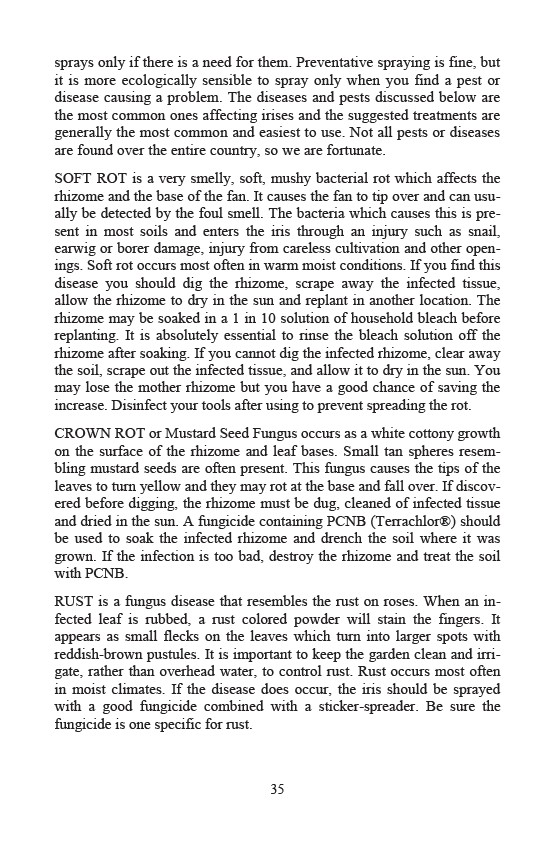
sprays only if there is a need for them. Preventative spraying is fine, but
it is more ecologically sensible to spray only when you find a pest or
disease causing a problem. The diseases and pests discussed below are
the most common ones affecting irises and the suggested treatments are
generally the most common and easiest to use. Not all pests or diseases
are found over the entire country, so we are fortunate.
SOFT ROT is a very smelly, soft, mushy bacterial rot which affects the
rhizome and the base of the fan. It causes the fan to tip over and can usu-ally
be detected by the foul smell. The bacteria which causes this is pre-sent
in most soils and enters the iris through an injury such as snail,
earwig or borer damage, injury from careless cultivation and other open-ings.
Soft rot occurs most often in warm moist conditions. If you find this
disease you should dig the rhizome, scrape away the infected tissue,
allow the rhizome to dry in the sun and replant in another location. The
rhizome may be soaked in a 1 in 10 solution of household bleach before
replanting. It is absolutely essential to rinse the bleach solution off the
rhizome after soaking. If you cannot dig the infected rhizome, clear away
the soil, scrape out the infected tissue, and allow it to dry in the sun. You
may lose the mother rhizome but you have a good chance of saving the
increase. Disinfect your tools after using to prevent spreading the rot.
CROWN ROT or Mustard Seed Fungus occurs as a white cottony growth
on the surface of the rhizome and leaf bases. Small tan spheres resem-bling
mustard seeds are often present. This fungus causes the tips of the
leaves to turn yellow and they may rot at the base and fall over. If discov-ered
before digging, the rhizome must be dug, cleaned of infected tissue
and dried in the sun. A fungicide containing PCNB (Terrachlor®) should
be used to soak the infected rhizome and drench the soil where it was
grown. If the infection is too bad, destroy the rhizome and treat the soil
with PCNB.
RUST is a fungus disease that resembles the rust on roses. When an in-fected
leaf is rubbed, a rust colored powder will stain the fingers. It
appears as small flecks on the leaves which turn into larger spots with
reddish-brown pustules. It is important to keep the garden clean and irri-gate,
rather than overhead water, to control rust. Rust occurs most often
in moist climates. If the disease does occur, the iris should be sprayed
with a good fungicide combined with a sticker-spreader. Be sure the
fungicide is one specific for rust.
35